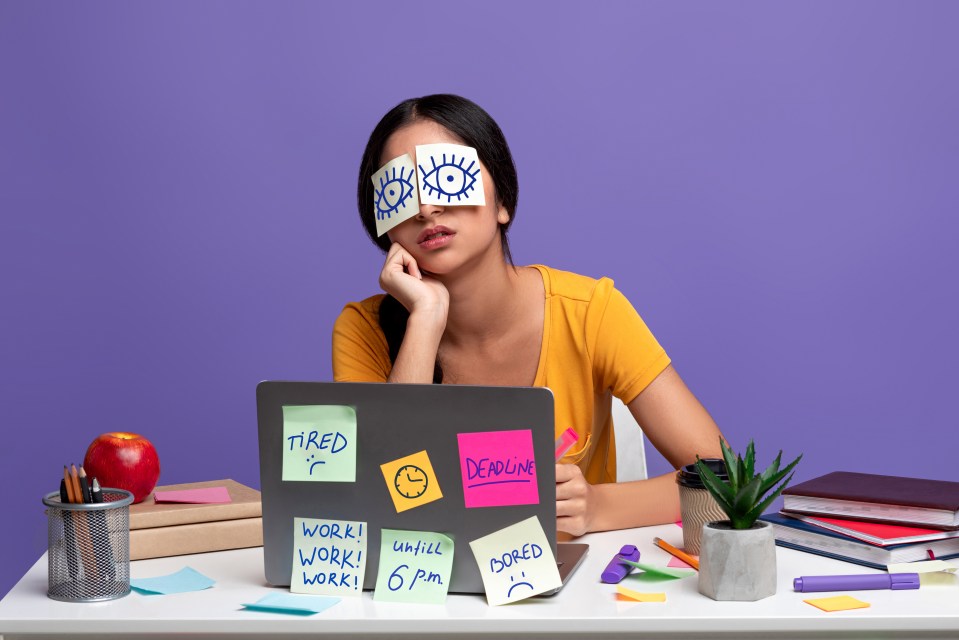WANT to ditch the distractions? Experts reveal the secrets to feeling more in control of your life.
Online shopping, TikTok, browsing recipes. . . what’s your distraction go-to?
Life can feel like a never-ending to-do list, but that doesn’t stop us wasting time.
The typical Brit can only focus for 17 minutes, according to a recent poll.*
“Our attention spans are eroding at rapid speed,” says Emily Austen, author of Smarter: 10 Lessons For A More Productive And Less-Stressed Life.
“Many of us are uncomfortable sitting without checking for notifications or digital stimulation. Watching TV while scrolling on our phones is common.”
What’s behind our dwindling focus?
“It has a lot to do with the way apps are designed – they give us a dopamine hit that is incredibly addictive,” says Emily.
“Our short attention spans are also a consequence of desire for shiny, new things – flicking open our phone for no reason means we are actively seeking out the hit, rather than passively waiting for it,” she adds.
Scrolling through Instagram or TikTok might feel soothing in the moment, but it triggers a stress response once we put our phone down, a new study from Durham University has confirmed.
Ultimately, your more pleasurable activity could have a rebound effect, and putting off tasks may actually hamper your productivity and your success.
Here’s how to take back control…
Why Do You Procrastinate?
Procrastination does not equal laziness.
Instead, it’s usually one of three things: “You’re scared, you actually don’t want to do the thing, or it is not the right time,” says Megan Hellerer, life coach and author of Directional Living.
“Ask yourself, am I afraid? Assess, address or at least acknowledge whatever fears come up,” she says.
“Then, weigh up whether it is something you think you should do, but don’t actually want to do. Finally, consider if it is the right timing. We have to be careful with this too, so as not to use it as an excuse.”
The reasons behind it
As Megan says, we may put off a task because we feel we should do it, rather than actually wanting to.
Some of these should-do tasks are unavoidable (putting the bins out, sorting bills), but sometimes they fall on our lap due to peer pressure or people-pleasing.
“These things do not feel inspiring or energising and they make you feel drained,” says Megan.
Perhaps it’s decluttering a space in your home because your mother-in-law comments on it when she visits.
If you have work-related procrastination, it could be rooted in a dislike for your job.
“When most people say they want to be more productive, what they really mean is they want to feel more productive,” says Megan.
“They want to accomplish the things that actually matter to them. So, productivity isn’t just getting things done, it’s getting the right things for you done.”
Chris Griffiths, co-author of The Focus Fix: Finding Clarity, Creativity And Resilience In An Overwhelming World, says having a purpose is “a natural antidote to procrastination. When we have a sense of purpose, we can push through the boring tasks and find the confidence to tackle the tricky ones,” he adds.
Try a productivity hack
From the Pomodoro technique (breaking work into intervals) to “eating the frog” (doing the hardest tasks first), there are lots of hacks out there.
“Hacks are appealing, as a way to super-charge productivity quickly that doesn’t require a mindset overhaul,” says Chris.
“But they need to be applied consistently.” Much like doing a five-minute abs workout, the results will be more powerful if you use productivity hacks daily.
“Seeking creative ways to approach tasks adds interest, increases likelihood of success and is often correlated to a sense of purpose,” says Chris.
Perhaps make your environment more inviting with a scented candle and a herbal tea, or choose a reward for yourself after you’ve completed the task.
The four Procrastinator types
Emily explains how to identify which one you are:
The Performer: “They force themselves to do work by leaving everything until the last minute and justify it by saying: ‘I work well under pressure,’ but burn out and feel miserable,” says Emily.
Tip: “Break a task down into smaller 20-minute stages,” says Emily. “Use a desk timer, so you can time-block to help you focus. This will bring more awareness to where your time is going and add predictive time to tasks.”
The Self-deprecator: “They bully themselves into thinking they’ve achieved nothing, and confirm their own failure by avoiding doing the thing,” says Emily.
Tip: Use the stop, start, continue approach. Think of a particular goal, then stop doing something specific that is preventing progress, start doing something new that will benefit, and continue doing what you already find helpful.
The Overbooker: Maybe you never get things done because you take on too much, as opposed to actively procrastinating. “The overbooker is always talking about being busy and never having enough time,” says Emily. “They love a long to-do list, which they never get to the end of.”
Tip: “Focus on a maximum of three big decisions per day, which will help you learn how to separate the urgent from the important,” says Emily. “I have a rule that if someone else could do the job, they should. Delegation is about moving tasks along, and it allows you to focus on the things only you can do.”
The Novelty-seeker: Some people can’t stand doing the same things day in, day out. “They have always just had ‘the best idea’ and have boundless energy for something new, until there is something more exciting to pursue an hour later,” says Emily.
Tip; If you’re guilty of abandoning boring tasks, try to focus on one thing at a time. “Close tabs on your laptop, shut down your inbox, news app and Slack, so you aren’t distracted by a sexier prospect popping up on your screen,” says Emily. “Consider using noise-cancelling headphones and listening to a relaxing playlist, too.”
Go-To Productivity Tips
- Use the 10-second test “Where tasks take 10 seconds or less, do them immediately. These could include making a note, sending a text, Googling or downloading something,” says Emily. Could you make a list of 10-second tasks to get done in the first hour of the day?
- Track your energy, not your time “Most of us only have two to three high-functioning, creative hours of the day,” says Megan. “Figure out when your most productive hours are and be intentional about what you give that time to.” That will make you feel less guilty for the slow-paced tasks at 4pm.
- Batch tasks “Task-switching takes energy and time,” says Megan. “To minimise feeling drained, ‘batch’ your to-do list and days. So, do all the small busy work and home chores together, and all the deep-thought work activities together.”
- Daydream Feel like you’re not moving forward with a task? Give yourself time to think. “Daydreaming is a crucial neurological function,” says Chris, plus it has been linked to boosted creativity and problem-solving. “A break away from work, allowing your mind to wander, can be mentally replenishing and helpful in breaking creative stagnation.”








